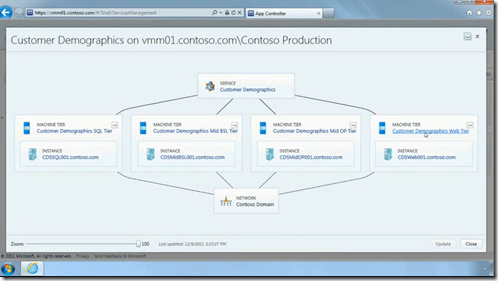Managing a hybrid cloud with System Center 2012
Hybrid cloud is the term applied to the increasingly common scenario where a business runs some of its services in the public cloud but retains some on premises, although it is also possible to use assets from both to provide a service as well. For some business this is just a transitional step as more and more services are moved to the public cloud, but for many organisations this might be the long term situation as some services can only be run internally.
For services/applications running in your own data centre you have a large degree of control over everything that application runs on, and you can tune and tweak that as you see fit. You get slightly less control as you outsource use hosting or run on someone else’s "Infrastructure as a Service" cloud platform. However with "Platform as a Service" like Microsoft Azure there is less to manage; you loose control of the operating system and only have limited ability to set storage, and compute resources. This is a good thing as it increase agility and reduces management overheads, but it does still need management.
This loss of control reminds of the early days of banking, you lost control of where your money actually was in fact you couldn’t point to a fiver in a bank vault and say that it was yours. However you still had control of which types of accounts to put your money in and you would be foolish not to request and make decisions on the bank statements you were sent. In the electronic world of the cloud you don’t have bank statements you have something like the Azure Management Portal..
which shows you how your services are deployed and allows you to change them as you see fit for example to deploy more web front ends, change the schema of your SQL Azure database..
and so on..
That’s fine if you run all of your services in the public cloud, however if you also have a data centre you’ll probably want to see an overview of how everything is working and be able to report to management on how all your services are performing no matter where they are. Not only that you’ll want one set of tools to make whatever changes you need bearing in mind the limitations of what can be changed in a cloud service. There are several tools in System Center 2012 to directly interact with Azure and whatever you have running in your data centre to provide the monitoring and control you need;
System Center Operations Manager has an Azure management pack to report on your Azure performance and setup in addition to a raft of other management packs to manage databases, switches, hardware, various operating systems, and numerous applications. The Azure management pack has to be configured with certificates and then uses Azure storage as an intermediate cache for storing and then transmitting the required telemetry down to the local Operations Manger database.
Note this can all be done in Operations Manager 2007 R2 (CU3 or later)
System Center Application Controller is a new tool for System Center 2012 that provides a web portal showing what is running in your private and public clouds. The private cloud works by pulling in data from System Center Virtual Machine Manager 2012. This latest release of Virtual Machine Manager now allows private clouds to be created and managed on different hypervisor platforms; Citrix Microsoft Hyper-V and Vmware. Application Controller also connects to your Azure services using a management certificate (as Operations Manager does) to secure this ..
Delegated users can create or enhance their own services from here.
However for more control you may wish to create more rigorous but still automated process using your help desk (e.g. System Center Service Manager, Remedy etc.) hooked up to these tools. For that there is System Center Orchestrator which allows run books to be setup with approval process, to capture additional data such as cost centre department etc. and carry out additional configuration tasks.
One thing to note that is this is all IT Professional stuff, System Center 2012 is designed for us, not for bank managers, marketeers or accountants. With my business intelligence background I would also recommend that for large and complex organisations you overlay System Center with a BI solution like SharePoint, coupled with web parts for them to be able to initiate service requests. A lot of the tooling for this is already in System Center 2012 e.g. there are optional analysis services cubes in Virtual machine Manager, and extensive reporting services reports in Operations Manager.
So plenty to think about and keep us busy in 2012, and if you want to see some of this in action before trying it out yourselves (System 2012 betas can be downloaded here), you can come to one of our IT Camps on System Center.
Comments
Anonymous
June 12, 2012
Really nice information covered in this article. Would like to know more about the enhancements in the patch update process for hybrid clouds.Anonymous
June 12, 2012
BTW, found several mistakes in spellings and otherwise (like "...but it does still need management.l" looks like an extra I here after the fullstop). Also ("The Azure management pack has to e configured with..." should have been "The Azure management pack has to re configured with...").Anonymous
June 18, 2012
Hi, fixed the typos and apologies for that ! You question about patching for hybrid cloud is a simple one, you only patch the bits of that under you controls just the VMs you have. When it comes to platforms like Azure, or Services like Office 365, we do the patching for you and you aren't directly aware of what's underneath. These VMs can be patched by Configuration Manager 2012 if you can connect to them from your System Center setup. Hope that helps Andrew


